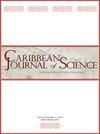Predation of a Juvenile Iguana rhinolopha (Squamata: Iguanidae) by Basiliscus plumifrons (Squamata: Corytophanidae) in the Costa Rican Rainforest
IF 0.5
4区 生物学
Q4 BIODIVERSITY CONSERVATION
引用次数: 2
Abstract
Abstract Lizards play key roles in ecosystems where they are prey for a wide variety of predators, including snakes, other lizards, mammals, birds, and invertebrates. The Green Basilisk (Basiliscus plumifrons; Squamata: Iguania: Corytophanidae) and the Green Iguana (Iguana rhinolopha; Squamata: Iguania: Iguanidae) are two large lizards usually found sympatrically in the lowland humid forests of Central America, and show the same diurnal, arboreal habits; both species are found near bodies of water. Male Green Iguanas can reach two meters in length; females up to 1.4 m. This species possesses a notable crest of comb–like spines along the neck, back, and tail, and a greatly enlarged smooth scale on the side of the throat. It is green, particularly so the juvenile individuals, and they commonly develop darker wavy transverse dorsal crossbands. The Green Basilisk can exceed 0.9 m in total length, although females are shorter. The coloration is emerald green with strikingly yellow eyes and conspicuous crests are present on the head, dorsum, and tail. This species feeds mainly on insects and other arthropods, but it also consumes flowers and fruits and occasionally eats vertebrates such as small lizards. On July 11, 2022 at 09:36 h we observed an adult Green Basilisk preying on a young Green Iguana at Selva Verde Lodge, located in tropical wet forest in northern Costa Rica. Herein, we present the details of this event in the context of lizard predatory encounters. Resumen Las lagartijas juegan un papel clave en los ecosistemas en los cuales son presa de una gran variedad de predadores tales como serpientes, otras lagartijas, mamíferos, aves e invertebrados. El basilisco verde (Basiliscus plumifrons; Squamata: Iguania: Corytophanidae) y la iguana verde (Iguana rhinolopha; Squamata: Iguania: Iguanidae) son dos lagartijas grandes que suelen encontrarse en simpatría en los bosques húmedos de tierras bajas de América Central y presentan los mismos hábitos diurnos y arbóreos; ambas especies se encuentran cerca de cuerpos de agua. Los machos de la iguana verde pueden alcanzar dos metros de longitud, mientras que las hembras alcanzan 1.4 m. Esta especie presenta una notable cresta de espinas en forma de peine en el cuello, la espalda y la cola, y una escama lisa muy agrandada en el costado de la garganta. Es verde, en particular los individuos juveniles, comúnmente con bandas cruzadas dorsales transversales oscuras y onduladas. El basilisco verde puede superar los 0.9 m de longitud total, aunque las hembras son más pequeñas. Es de color verde esmeralda con ojos amarillos notables y crestas conspicuas en la cabeza, el dorso y la cola. Se alimenta principalmente de insectos y otros artrópodos, pero también consume flores y frutos y ocasionalmente vertebrados como pequeñas lagartijas. El 11 de julio de 2022 a las 09:36 h observamos un basilisco verde adulto depredando a un neonato de iguana verde en Selva Verde Lodge en el Bosque Húmedo Tropical del norte de Costa Rica. Presentamos los detalles de este evento en el contexto de encuentros de depredación entre lagartijas.哥斯达黎加雨林中一头幼年鼻鬣蜥(鳞目:鬣蜥科)被扁蜥(鳞目:栉蜥科)捕食
摘要蜥蜴在生态系统中发挥着关键作用,在生态系统中,它们捕食各种掠食者,包括蛇、其他蜥蜴、哺乳动物、鸟类和无脊椎动物。绿蜥(紫蜥;鳞翅目:鬣蜥科)和绿鬣蜥(鬣蜥鼻目;鳞翅目:鬣蜥:鬣蜥科)是两种大型蜥蜴,通常在中美洲潮湿的低地森林中共存,并表现出相同的白天、树木习性;这两个物种都是在水体附近发现的。雄性绿色鬣蜥的长度可达两米;雌性高达1.4米。这种物种的脖子、背部和尾巴上有明显的梳状突起,喉咙侧面的光滑鳞片大大扩大。它是绿色的,尤其是年轻人,他们通常会发展深色的Wavy横向背越带。绿蜥蜴的总长度可以超过0.9米,尽管雌性更短。颜色为翠绿色,眼睛呈明显的黄色,头部、背部和尾部有明显的纹章。这种物种主要以昆虫和其他节肢动物为食,但也吃花和水果,偶尔吃小蜥蜴等脊椎动物。2022年7月11日09:36,我们在哥斯达黎加北部热带潮湿森林的丛林绿色小屋观察到一只成年绿色蜥蜴在捕食一只年轻的绿色鬣蜥。在这里,我们在蜥蜴捕食者相遇的背景下介绍了这一事件的细节。摘要蜥蜴在生态系统中发挥着关键作用,在这些生态系统中,它们是蛇、其他蜥蜴、哺乳动物、鸟类和无脊椎动物等各种掠食者的猎物。绿蜥(紫蜥;鳞片:鬣蜥科:鸬鹚科)和绿鬣蜥(鬣蜥鼻目;鳞片:鬣蜥:鬣蜥科)是两种大型蜥蜴,通常在中美洲低地潮湿的森林中共生,具有相同的白天和树栖习性;这两个物种都在水体附近。绿鬣蜥的雄性可达两米长,雌性可达1.4米。该物种的脖子、背部和尾巴上有明显的梳状刺脊,喉咙侧面有一个非常大的光滑鳞片。它是绿色的,特别是幼年个体,通常有黑色和波浪形的横向背交叉带。绿色蛇怪的总长度可能超过0.9米,尽管雌性较小。它是翠绿色的,有明显的黄色眼睛,头部、背部和尾部有明显的脊。它主要以昆虫和其他节肢动物为食,但也吃花和水果,偶尔也吃小型蜥蜴等脊椎动物。2022年7月11日09:36,我们在哥斯达黎加北部潮湿的热带森林的绿色丛林小屋里观察到一只成年的绿色蜥蜴在捕食一只新生的绿色鬣蜥。我们在蜥蜴之间的捕食会议的背景下介绍了这一事件的细节。
本文章由计算机程序翻译,如有差异,请以英文原文为准。
求助全文
约1分钟内获得全文
求助全文
来源期刊

Caribbean Journal of Science
综合性期刊-生物多样性保护
CiteScore
1.00
自引率
25.00%
发文量
21
审稿时长
>12 weeks
期刊介绍:
The Caribbean Journal of Science publishes articles, research notes, and book reviews pertinent to natural science of the Caribbean region. The emphasis is on botany, zoology, ecology, conservation biology and management, geology, archaeology, and paleontology. The mission as a nonprofit scholarly journal is to publish quality, peer-reviewed papers and to make them widely available.
 求助内容:
求助内容: 应助结果提醒方式:
应助结果提醒方式:


